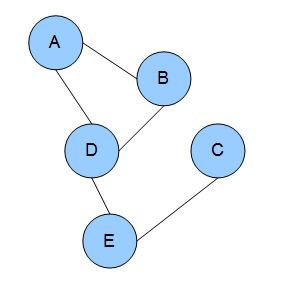 | ||
In the domain of physics and probability, a Markov random field (often abbreviated as MRF), Markov network or undirected graphical model is a set of random variables having a Markov property described by an undirected graph. In other words, a random field is said to be Markov random field if it satisfies Markov properties.
Contents
- Definition
- Clique factorization
- Logistic model
- Gaussian
- Inference
- Conditional random fields
- Varied applications
- References
A Markov network or MRF is similar to a Bayesian network in its representation of dependencies; the differences being that Bayesian networks are directed and acyclic, whereas Markov networks are undirected and may be cyclic. Thus, a Markov network can represent certain dependencies that a Bayesian network cannot (such as cyclic dependencies); on the other hand, it can't represent certain dependencies that a Bayesian network can (such as induced dependencies). The underlying graph of a Markov random field may be finite or infinite.
When the joint probability density of the random variables is strictly positive, it is also referred to as a Gibbs random field, because, according to the Hammersley–Clifford theorem, it can then be represented by a Gibbs measure for an appropriate (locally defined) energy function. The prototypical Markov random field is the Ising model; indeed, the Markov random field was introduced as the general setting for the Ising model. In the domain of artificial intelligence, a Markov random field is used to model various low- to mid-level tasks in image processing and computer vision.
Definition
Given an undirected graph
The above three Markov properties are not equivalent: The Global Markov property is stronger than the Local Markov property, which in turn is stronger than the Pairwise one.
Clique factorization
As the Markov properties of an arbitrary probability distribution can be difficult to establish, a commonly used class of Markov random fields are those that can be factorized according to the cliques of the graph.
Given a set of random variables
If this joint density can be factorized over the cliques of
then
Although some MRFs do not factorize (a simple example can be constructed on a cycle of 4 nodes), in certain cases they can be shown to be equivalent given certain conditions:
When such a factorization does exist, it is possible to construct a factor graph for the network.
Logistic model
Any Markov random field (with a strictly positive density) can be written as log-linear model with feature functions
where the notation
is simply a dot product over field configurations, and Z is the partition function:
Here,
The probability P is often called the Gibbs measure. This expression of a Markov field as a logistic model is only possible if all clique factors are non-zero, i.e. if none of the elements of
The importance of the partition function Z is that many concepts from statistical mechanics, such as entropy, directly generalize to the case of Markov networks, and an intuitive understanding can thereby be gained. In addition, the partition function allows variational methods to be applied to the solution of the problem: one can attach a driving force to one or more of the random variables, and explore the reaction of the network in response to this perturbation. Thus, for example, one may add a driving term Jv, for each vertex v of the graph, to the partition function to get:
Formally differentiating with respect to Jv gives the expectation value of the random variable Xv associated with the vertex v:
Correlation functions are computed likewise; the two-point correlation is:
Log-linear models are especially convenient for their interpretation. A log-linear model can provide a much more compact representation for many distributions, especially when variables have large domains. They are convenient too because their negative log likelihoods are convex. Unfortunately, though the likelihood of a logistic Markov network is convex, evaluating the likelihood or gradient of the likelihood of a model requires inference in the model, which is generally computationally infeasible (see 'Inference' below).
Gaussian
A multivariate normal distribution forms a Markov random field with respect to a graph
such that
Inference
As in a Bayesian network, one may calculate the conditional distribution of a set of nodes
Conditional random fields
One notable variant of a Markov random field is a conditional random field, in which each random variable may also be conditioned upon a set of global observations
Varied applications
Markov random fields find application in a variety of fields, ranging from computer graphics to computer vision and machine learning. MRFs are used in image processing to generate textures as they can be used to generate flexible and stochastic image models. In image modelling, the task is to find a suitable intensity distribution of a given image, where suitability depends on the kind of task and MRFs are flexible enough to be used for image and texture synthesis, image compression and restoration, image segmentation, surface reconstruction, image registration, texture synthesis, super-resolution, stereo matching and information retrieval. They can be used to solve various computer vision problems which can be posed as energy minimization problems or problems where different regions have to be distinguished using a set of discriminating features, within a Markov random field framework, to predict the category of the region. Markov random fields were a generalization over the Ising model and have, since then, been used widely in combinatorial optimizations and networks.
